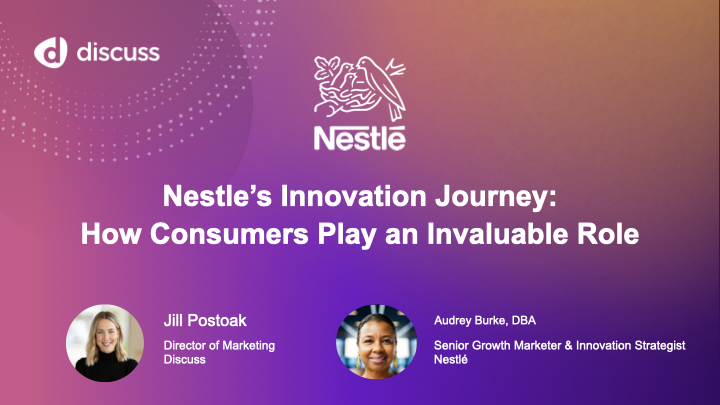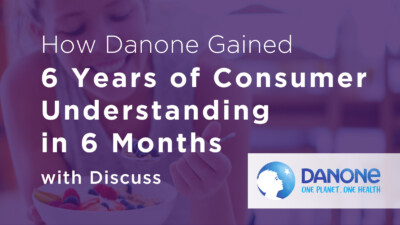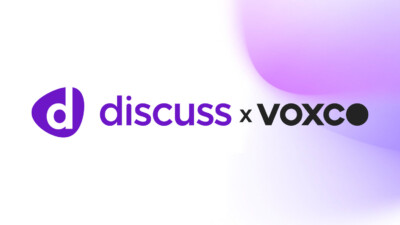Nestlé’s Accelerator Shows What Happens When the Whole Company Listens

By Jill Postoak, Director of Marketing, Discuss
When I joined Nestlé’s Audrey Burke on stage recently at the Insights Association’s Corporate Researchers Conference (CRC), one theme kept surfacing: what happens when more people across a company – not just researchers – get to hear directly from consumers?
That idea has become real inside the Nestlé Accelerator. The program gives marketers, product managers, and other non-researchers direct access to consumer conversations, supported by a platform that handles logistics and analysis.
Now research isn’t a black box anymore. Teams use consumer input as they work, instead of waiting for a distant handoff.
This is a recap of our session: what Nestlé built with Discuss, what they’ve seen in the first year, and why it matters for anyone leading insights or marketing.
How do you do something in 6 months that normally takes 2 years?
To ground our session, Audrey shared this quote from Clayton Christensen, author of “The Innovator’s Dilemma”: “Most innovative companies fail not from a lack of ideas, but from failing to understand what customers truly want.”
Nestlé’s R&D North America team knows this challenge firsthand.
They juggle product, digital, and open innovation while staying connected to Nestlé’s global network. Their mission: spot early opportunities, share insights quickly with categories, and move promising ideas forward without slowing the pipeline.
That’s tough when traditional innovation cycles can take up to two years, but the goal is six months from idea to shelf.
Consumer voices were meant to guide every step. In practice, they often faded as projects moved from concept to execution. Researchers could manage that tension, but marketers and product managers weren’t always in the room.
So how do you keep the consumer close with speed and scale? The Accelerator was built to do that: to bring consumer voices back into the process, compress timelines, and avoid chasing the wrong ideas.
The Accelerator solution: faster research, same rigor
Nestlé designed the Accelerator as an “exploration engine” that combines research quality with easy, self-serve access. Using Discuss as the backbone, the model lets cross-functional teams join live sessions or run lightweight studies without needing to be research experts.
The setup is straightforward: Discuss handles recruiting, moderation, tech, and analysis. Teams just show up, listen, and leave knowing which ideas deserve attention.
AI supports the process by packaging insights and spotting patterns quickly, but the core value comes from hearing consumers in their own words.
The six-month sprint, then scale at twelve
The Accelerator started with speed in mind. From idea to shelf in six months, teams ran rapid cycles of problem framing, solution design, test prep, and in-market learning.
By month six, they had proof the model worked – validating good ideas, pivoting when feedback demanded, and shelving weak bets before they burned resources.
By month twelve, it was no longer an experiment. The same model scaled across projects and produced clear results:
- 140+ hours of consumer interviews
- 150+ respondents engaged
- 60+ Nestlé employees participating directly
- 1,000+ clips and moments saved for reuse
More important than the numbers was the shift in mindset. As one team member put it: “Now I feel closer to the business after connecting with the customer.” Marketers and product managers who once worked several steps removed from the consumer were now shaping decisions based on what they’d heard firsthand.
Two examples shared on stage
Beyond the metrics, Audrey shared these two stories to illustrate how effective The Accelerator is:
1. Early-stage problem framing
Instead of waiting weeks for a research report, marketers sat in on live sessions. Hearing consumers describe frustrations directly gave them immediate empathy, and AI summaries made it easy to act the next day.
2. In-store shop test
For a functional beverage placement study, the team ran an asynchronous test. Consumers captured photos and videos while shopping, then shared reactions. The findings shaped placement strategy and gave leadership confidence to move ahead.
Both examples show the same principle: when consumer voices are accessible, decisions improve.
Why this matters to researchers and marketers
For researchers, the model extends influence. They still set quality guardrails and interpret nuance, but they’re no longer the bottleneck for every business question.
For marketers, the model removes barriers. They can validate ideas, pressure-test messaging, or explore new categories without waiting weeks for access.
The division of labor is clear: Discuss handles the heavy lifting, researchers provide guidance, and non-researchers gain firsthand understanding. Everyone benefits.
Key lessons from year one
- Direct engagement drives innovation. You can’t outsource empathy. Hearing consumers firsthand changes decisions.
- AI speeds the process, but doesn’t replace it. Summaries and pattern recognition help, but conversations matter most.
- Participation builds ownership. When dozens of employees hear consumers, alignment improves naturally.
- Failing forward works if consumers stay in view. Feedback gives teams confidence to pivot or stop investment.
Nestlé’s own reflections echo this: stay human-centric even as AI tools expand, use partnerships to accelerate learning, and spread consumer access across the organization.
Why it matters for the industry
The Nestlé Accelerator is more than a case study. It shows how a global brand can bring more voices into the room without losing rigor and how faster cycles don’t have to mean lower quality. It demonstrates how AI can enable consumer closeness while keeping researchers in the driver’s seat.
For the broader insights industry, it signals a shift. The old model of insights teams working in isolation, delivering reports weeks later, is being replaced by real-time collaboration. Researchers are now setting the standards while enabling the rest of the business to join in.
It also challenges how organizations think about scale. Scaling research used to mean outsourcing more work to agencies. Now it can mean equipping employees to engage directly, with platforms ensuring quality and consistency. That’s a different kind of leverage that creates shared ownership of consumer closeness across functions.
And finally, it points to a competitive reality: speed matters, but so does confidence. Companies that learn quickly and ground decisions in consumer input will outpace those still relying on long cycles and secondhand summaries. Nestlé’s model shows that it’s not only possible, but practical.
Final thought and next step
If your research cycles still take years, Nestlé has shown a faster path. The lesson is clear: give more people access to consumers, let AI handle the repetitive work, and keep human connection at the center.
To see the full story and adapt it for your teams, watch the recording of our session. It’s an hour well spent on how research can become simple enough for everyone, not just the experts.
Ready to unlock human-centric market insights?
Related Articles

Predictive Agentic AI for Campaign Testing: Forecasting Success Before Launch
Imagine being able to predict how your next marketing campaign will perform—before you spend a dollar on media. That’s the…
Imagine being able to predict how your next marketing campaign will perform—before you spend a dollar on media. That’s the…

How to Use AI Agents for Smarter Marketing Campaigns
How do you make sure your next campaign hits when yesterday’s data is already outdated? Too many teams are stuck…
How do you make sure your next campaign hits when yesterday’s data is already outdated? Too many teams are stuck…



